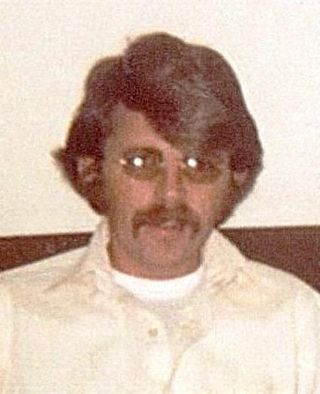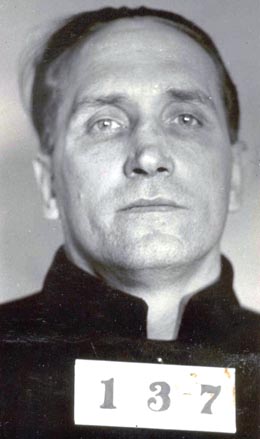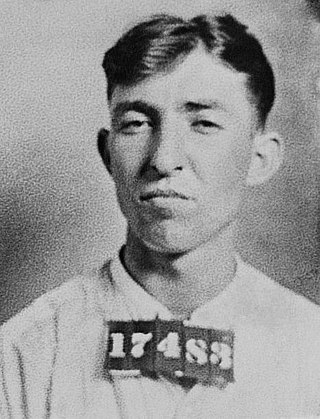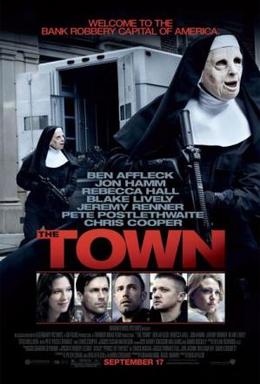Related Research Articles

Bank robbery is the criminal act of stealing from a bank, specifically while bank employees and customers are subjected to force, violence, or a threat of violence. This refers to robbery of a bank branch or teller, as opposed to other bank-owned property, such as a train, armored car, or (historically) stagecoach. It is a federal crime in the United States.

James Burke, also known as "Jimmy the Gent", was an American gangster and Lucchese crime family associate who is believed to have organized the 1978 Lufthansa heist, the largest cash robbery in American history at the time. He was believed to be responsible for the deaths of those involved in the months after the robbery.
The Brink's-Mat robbery occurred at the Heathrow International Trading Estate, London, United Kingdom, on 26 November 1983 and was one of the largest robberies in British history. £26 million worth of gold bullion, diamonds, and cash was stolen from a warehouse operated by Brink's-Mat, a former joint venture between US security company Brink's and London-based company MAT Transport. The bullion was the property of Johnson Matthey Bankers Ltd. Micky McAvoy and Brian Robinson were convicted of armed robbery. Most of the gold has never been recovered. Lloyd's of London paid out for the losses, and several shooting deaths have been linked to the case.

Seafirst Corporation was an American bank holding company based in Seattle, Washington. Its banking subsidiary, Seafirst Bank, was the largest bank in Washington, with 235 branches and 497 ATMs across the state.

Leslie Isben Rogge is an American bank robber who was the first criminal on the FBI's Ten Most Wanted Fugitives to be apprehended due to the internet.
The Chelambra bank robbery in the Malappuram district of Kerala, India is considered to be one of the biggest and most sensational bank robberies in the crime history of Kerala. In the early hours of 30 December 2007, the robbers made a hole in the floor of the Kerala Gramin Bank and got away with 80 kilograms of gold and 5,000,000 rupees, a total value of 80 million Indian Rupees.

Edward Wilhelm Bentz was an American bank robber and Depression-era outlaw. He was associated with several high-profile public enemies during his criminal career, including Harvey Bailey, Albert Bates, George "Machine Gun" Kelly and Baby Face Nelson. He was eventually captured by the FBI and sentenced to Alcatraz.

Albert Lawrence Bates was an American bank robber and burglar during the 1920s and 1930s. He used a number of different aliases during his criminal career including George Davis, George Harris and J.B. King. He was the longtime partner of George "Machine Gun" Kelly. He also took part in the kidnapping of oil magnate Charles Urschel in July 1933.

The Holden–Keating Gang was a bank robbing team, led by Thomas James Holden and Francis Lawrence Keating, which was active in the Midwestern United States from 1926 to 1932. Holden was described by a spokesman for the FBI as "a menace to every man, woman, and child in America" and was the first fugitive to be officially listed on the FBI's Top Ten Most Wanted List in 1950.

Harold Eugene "Eddie" Green was an American bank robber and Depression-era outlaw during the 1930s, best known as a member of the John Dillinger gang. He was also associated with Frank "Jelly" Nash, Volney Davis and the Barker-Karpis Gang in his early career.

Frederick Grant Dunn (1905–1959) was an American criminal, burglar and bank robber whose career spanned over four decades from 1919 until his mysterious death in 1959. He led a small gang during the 1940s and 1950s, Dunn becoming referred to by the press as "the modern John Dillinger", and whose activities eventually resulted in his being listed on the FBI's Ten Most Wanted in 1958.

The Town is a 2010 American crime thriller film co-written, directed by, and starring Ben Affleck, adapted from Chuck Hogan's 2004 novel Prince of Thieves. It also stars Rebecca Hall, Jon Hamm, Jeremy Renner, Blake Lively, Titus Welliver, Pete Postlethwaite, Chris Cooper and Slaine, and follows a Boston bank robber who begins to develop romantic feelings for a victim of one of his previous robberies, while he and his crew set out to get one final score by robbing Fenway Park.
The Trenchcoat Robbers, Ray Lewis Bowman and William Arthur "Billy" Kirkpatrick, are a pair of bank robbers from the United States. Their biggest heist was the February 1997 robbery of a Seafirst Bank branch in Lakewood, Washington that netted $4.4 million. Their modus operandi involved picking the lock of closed banks, tying up the employees, and stealing from the vault. Their first robbery is believed to have happened in September 1982. Their disguises included trenchcoats, wigs, fake mustaches, hats and glasses. They are believed to have robbed 28 banks in the United States.

Anthony J. Curcio is an American author, public speaker, convicted robber, and former career criminal. In 2008, Curcio was responsible for one of the most elaborately planned armored car heists in U.S. history. He was eventually arrested and sentenced to six years in federal prison. Upon his release from prison, he parlayed his criminal career into becoming a motivational speaker, in the field of drug abuse and crime prevention, speaking to students and athletes across the U.S.
Jeffrey Shuman is an American-French bank robber, dubbed "The Vaulter", considered to be one of Canada's most prolific bank robbers. In 1994, he pleaded guilty to robbing 14 banks in the United States, receiving a 12-year sentence, but was released in 2004, and fled the country while on parole. He then robbed 21 banks in Canada, before fleeing to France on his French passport. In 2016, he was extradited to Canada, and in 2017, was sentenced to 15 years in prison and ordered to pay back nearly $450,000 in restitution after pleading guilty to seven counts of robbery using a firearm.

The Bonded Vault heist was the August 1975 robbery of the Bonded Vault Company, a commercial safe-deposit business occupying a vault inside Hudson Fur Storage in Providence, Rhode Island. It served as the unofficial "bank" used by the Patriarca crime family and associates. The stolen valuables were worth about $30 million. According to The Providence Journal, it was among the biggest heists in US history and resulted in the longest and costliest criminal trial in Rhode Island history.
The 1973 Canadian Imperial Bank of Commerce bank robbery occurred in Kenora, Ontario, Canada, on May 10, 1973. A robber entered the Canadian Imperial Bank of Commerce with firearms, a bomb, and bags to hold money. Upon leaving the bank, accompanied by an undercover police officer, he was shot by a police sniper and the bomb detonated. The robber was killed and the officer injured. The robber has never been identified.
Ashulia bank robbery was a robbery of the Ashulia branch of Bangladesh Commerce Bank Limited by members of Jama'atul Mujahideen Bangladesh and Ansarullah Bangla Team, both of which are Jihadist terror organizations, to raise funds for terror attacks in 2015. The terrorists killed 7 civilians in the bank during the robbery and one terrorist was killed while fleeing the scene. In 2016, six of the robbers were sentenced to death for their part in the robbery.
The Lincoln National Bank robbery took place on September 17, 1930 when a group of armed men entered a bank in Lincoln, Nebraska, stole approximately $2.7 million in cash and securities, and then fled with help of a getaway driver. No one was seriously injured during the robbery. The majority of the money was never recovered.
References
- 1 2 3 4 5 6 7 8 9 Anderson, Rick (January 9, 2014). "The biggest armed bank robbery in American history began shortly after closing". Seattle Weekly . Retrieved January 30, 2024.
- 1 2 3 4 "Man's arrest may unravel bank heist". The Spokesman-Review . Associated Press . Retrieved January 30, 2024.
- 1 2 3 "'Trench Coat Robber' convicted". Tulsa World . Associated Press. November 7, 1998. Retrieved January 30, 2024.
- 1 2 3 4 5 6 7 8 9 Jackman, Tom (November 6, 1998). "Encore of $8 million run: 355 lbs. of cash and 2 trench coats". The Washington Post . ISSN 0190-8286 . Retrieved January 30, 2024.
- 1 2 3 4 5 6 7 Kotlowitz, Alex (June 30, 2002). "The Rise and Fall of the Trenchcoat Robbers". The New Yorker . ISSN 0028-792X . Retrieved January 30, 2024.
- 1 2 3 "'Trench coat robber' convicted in bank heists". The Seattle Times. Associated Press. November 7, 1998. Retrieved January 30, 2024.
- ↑ Gillie, John (March 20, 1999). "'Trench Coat Robber' sentenced". The News Tribune . p. B1. Retrieved January 30, 2024– via Newspapers.com.
- ↑ "'Trench-coat' robber pleads guilty". The Seattle Times. March 26, 199. Retrieved January 30, 2024.